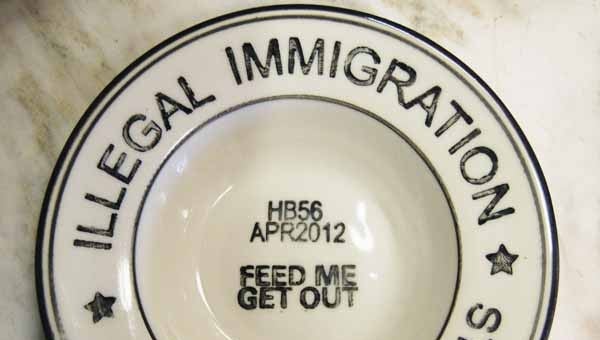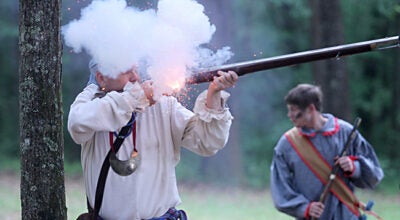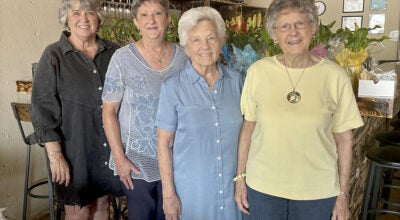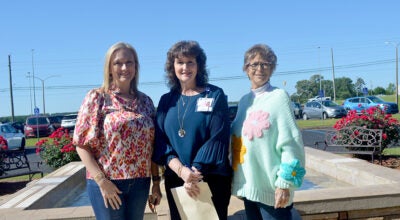Troy director’s art pulled from show for being too controversial
Published 11:00 pm Friday, January 18, 2013

Three pieces of artwork by Ed Noriega were pulled from an art show at the Heritage Hall Museum in Talladega last week by the museum’s board.
Three pieces of artwork by Ed Noriega were pulled from an art show at the Heritage Hall Museum in Talladega last week by the museum’s board.
Noriega’s artwork was part of the Troy University Faculty Art Show that was scheduled to hang at the Talladega museum and is a commentary on Alabama’s immigration law.
Pam Allen, interim chair of Troy University Department of Art and Design, said that the exhibit was to be a Troy University faculty show. The other faculty members who had contributed to the show agreed that if Noriega’s work could not be shown, it would not be a “faculty” show and they would not participate in the show. As a result the Troy University Faculty Art Show exhibit was pulled from the Heritage Hall Museum.
Kelly Williams, Heritage Hall Museum office manager, said the decision to pull the show was made by the commission that governs the body of the museum.
“There were three of Ed Noriega’s pieces that the commission did not think were appropriate to be shown at Heritage Hall Museum,” Williams said. “One was a stack of cans that had swastikas on the top and two dealt the Virgin Mary. The commission thought that these pieces were not appropriate and there could be strong negative feelings about them. The commission stood by its principles and pulled the show.”
Williams said Pam Allen had a show at Heritage Hall Museum and the museum looks forward to working with Troy University in the future.
Noriega, Director of the Center for Design, Technology & Industry at Troy University, said that he is passionate about what he believes and uses his art as a venue to get his message out about the issue of immigration.
“The artwork deals with the Alabama immigration law passed last year and the main point that I wanted to get across is that we depend economically, morally and financially on immigrant labor to feed and clothe us,” Noriega said. “Immigrants do the work that is not necessarily the kind of work others want to do. The jobs they do are mainly low-paying and are hard work and have no benefits.”
Noriega said that, if it were not for immigrant labor, the produce that Americans pay two dollars a pound for would cost three to four times that much.
“These immigrants do contribute to the economy,” he said. “They pay sales taxes on food and clothing and other things they buy. But their major contribution is the labor they provide at minimum wage or below and that keep the prices down at grocery markets where we are all going to feel the adverse effects of Alabama’s immigration law.
“The immigration law that Alabama passed picks on people who are more victims than they are culprits. We are shooting ourselves in the foot.”
Noriega said the real culprits are the high tech industries that are sending high paying jobs to China and India.
Noriega said Alabama’s immigration law could be considered a form of ethnic cleansing.
“That’s interesting because we are all immigrants to this country,” he said. “And, it’s hard to understand how, in the Bible Belt, there could be so much indifference to the way people are being treated. There seems to be little church involvement, little compassion. How can we turn our backs and not look at families that have been told to leave. We need to look in the mirror but we won’t because we don’t want to see how horribly we are treating people. We want to believe that we are on the right side and don’t want to hear anything else.”
Noriega said that his work that was rejected by the Talladega museum is drawing a lot of dialogue and hopefully has people thinking and talking.
“We don’t need to be afraid to speak up and say what we believe to be right, even if it’s out of the ordinary,” he said. “With my art, I was not trying to offend anyone. I was hoping to get others to consider the issue with immigration and decide for themselves what is right and what is wrong and then have the courage to speak up. Maybe Heritage Hall Museum did me a favor by making a thing of it. Maybe they did.”
The Troy University Faculty Show was featured at the Wiregrass Museum of Art in Dothan July through October 2012, complete with all five of Noriega’s pieces.
Katie Wainwright, museum curatorial assistant, said the show was well received and there was no controversial dialogue surrounding the show.
“The show received a good reception and Ed Noriega’s artwork was not an issue,” Wainwright said. “If there was any question about it, it was not a big enough to pull the pieces. It was important to show the complete exhibit, not pick and choose the pieces.
“To my knowledge, no one brought Ed Noriega’s artwork to our attention or was offended by it.”




